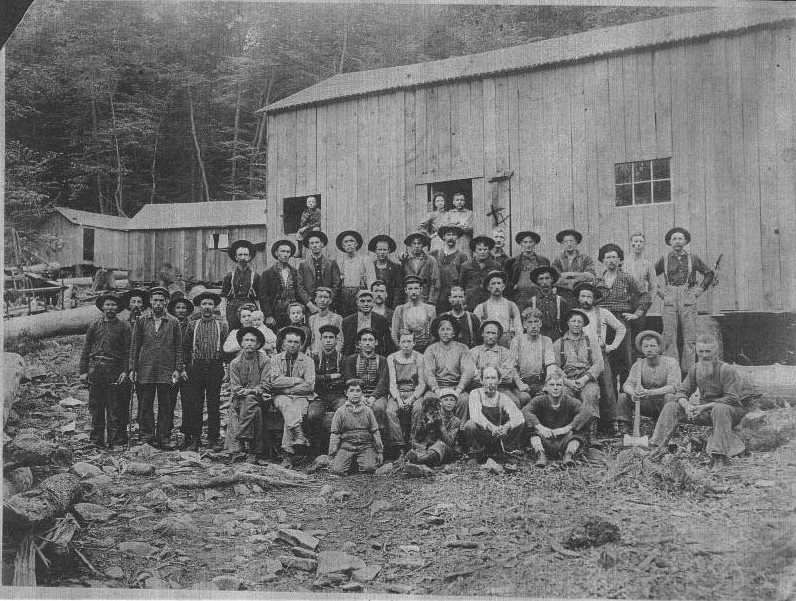The life of a lumber man and his family was dangerous, exhausting and lonely. But it often gave income to a family that was otherwise unavailable
in the rural environment of Bradford, Sullivan and Lycoming Counties in northern Pennsylvania. In additon to those itinerant laborers who made a career of
"following the saw", many others worked at it part time or seasonally to supplement what they might otherwise make from farming or hand labor. The followin stories posted elsewhere
on this site tell us something about this life and provide pictures of the work environment and some of the men who lived in it:
(1) Settlers XVII:
Frank Farrell: A Death in the Forest
(2) Settlers XVIII: The Sones, Simmons and Stevenson Families: Elders, Patriots and Lumber Barons--Scroll down to the section entitled
Charles Wesley Sones and the Story of Sonestown.
(3) Sullivan County Industries: Now and Then--Scroll down to the section
entitled Log of Lumbering. A major source of the information written there was Otto Little, Carl Rightmire's brother-in-law.
We also will occasionally post new logging pictures from other sources that come into our hands from auctions, other contributors and so forth. Here is an
example--a picture that Bob Sweeney bought on eBay in January 2005 from a collector in Towanda, PA, who in turn had bought it at an antique auction in
Central Pennsylvania. George Burgess and Bob both looked over the photo and could not identify the individuals shown in the picture, although we can surmise that the time frame is
around the early twentieth century. We also know the picture was taken or at least was kept in Dushore, Sullivan County, PA because that location is handwritten on the back. If any of our viewers
recognizes any of the men in the picture, we would be delighted to hear from them. Bob donated the picture to the Sullivan County Historical Society and Museum after scanning and conserving it.
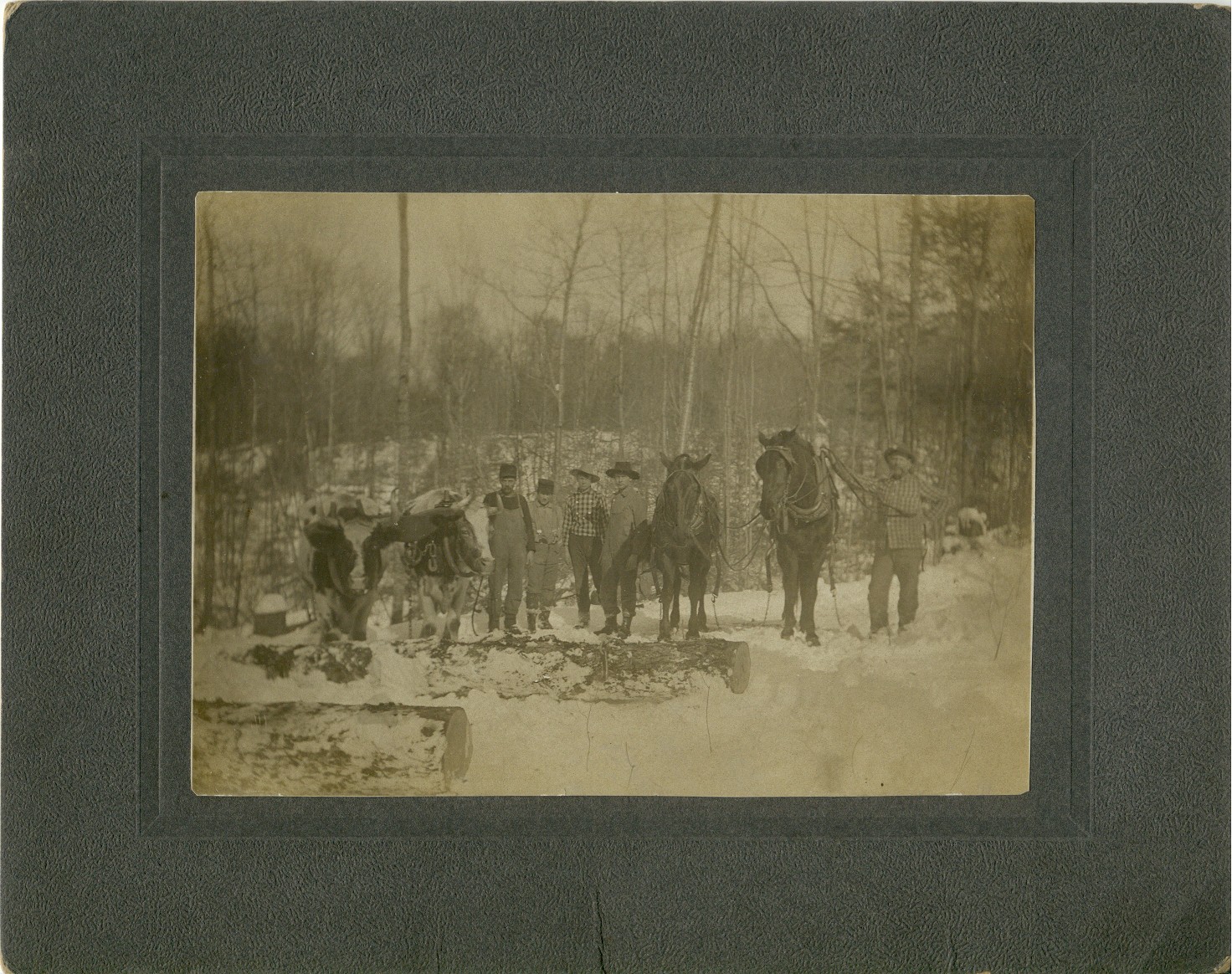
Early Twentieth Century Logging Photo
Parties Unknown
Source: Purchase from eBay by Bob Sweeney
Donated to the Sullivan County Historical Society
Click on Logging Photo to see a full scale image.
Here is another example that was printed in the Rocket Courier, Wyalusing, PA on October 27, 2005. The caption states that this photo is part of a collection of glass slides of old logging camps, this one being in Sullivan County, from the turn of the twentieth century:
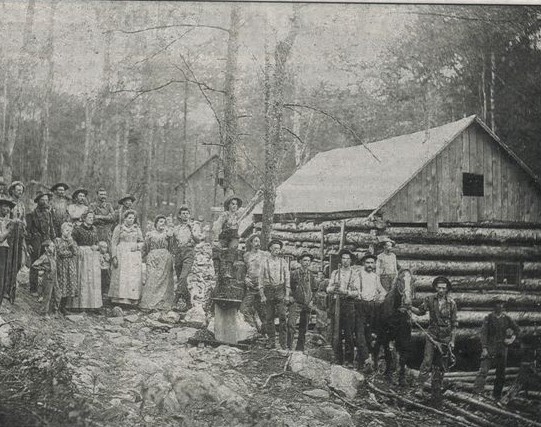
Logging Camp
Sullivan County, PA
About 1900
Source: Rocket-Courier, Wyalusing, PA, October 27, 2005
All rights reserved.
Part of a collection in the possession of
Jim Nelson, retired Pennsylvania State Forester.
Finally, on January 19, 2006, The Sullivan Review published an old picture and commentary about several loggers aboard an excursion train from Eagles Mere dated 1902 or 1903. You can click here to see the newspaper photo and commentary. In the article, George Burgess was credited with several of the identifications; however, the picture caption did not link these identifications to the men shown in the picture. After we contacted George, he wrote a letter to the newspaper, shown below, and provided to us his own version of the same picture with a set of identifications. They are presented here.
Feb 1, 2006
Dear Sirs:
It was fun to see that the Museum sent in the picture of the Eagles Mere Excursion train, published in the January 19, 2006 Sullivan Review. Bob Sweeney, who administers and maintains a very good genealogical website devoted to Sullivan County at www.rootsweb.com/~pasulliv/ , has asked me to send the photo to him for inclusion on the website. You can now find the picture there, under "The Lost World of the Loggers", along with a numbered key identifying those known. Under the same title, Mr. Sweeney has posted about eight logging camp photos from 1906 to 1917, along with a numbered key and identifications of those known. We invite you to visit the web site, and if you can identify any other people in the pictures, contact us. I have already been contacted by several people who were excited to find a picture of their ancestor from his days logging in the hills of Sullivan County.
Sincerely,
George Burgess
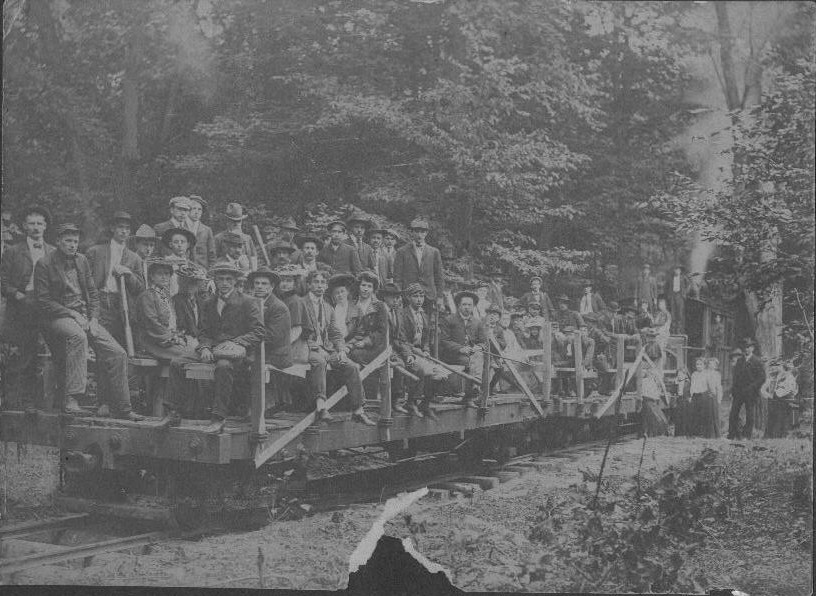
Excursion Train
From Eagles Mere to Hillsgrove
Near Dry Run
1902-3
Source: Photo Collection of George Burgess
Click to see a version of the same picture with the individuals numbered.
Then you can compare the numbers to the following Identifications by Carl Rightmire
`
Actually before this exchange, back in December 2004, George Burgess greatly expanded our history and understanding of this part
of our heritage. He contributed most of the photographs shown below to the Sullivan County Genealogical Society Web Page.
Identifications of the people in the pictures were made by his grandfather, Carl Rightmire, who actually is shown in
several of these pictures, back in 1972. George also developed most of the following story. We are very grateful to George for bringing this material to our attention.
These old photographs and records help us to understand the lifestyle, difficulties and sense of accomplishment of the men, and their families who often accompanied them. So, let's turn the
"microphone" over to George.
Early Logging; Logging Camp Pictures
Below is an interactive map showing the approximate locations of various Lumber Camps pictured
on this site. Click on a camp symbol for a photograph of the timber crew at that Camp (all protographs also shown in the body of
this site), and a little additional information, if known.
It would be fun to add other Camp locations to this map. If you know of a camp location, please email George Burgess
at sglburgess@gmail.com.
:
:
My Grandfather, Carl Rightmire,
was a woodsman. He lived near Hoppestown (near Proctor) in Lycoming County and
worked extensively in the woods in Sullivan County in the early 1900’s. At that
time the lumber companies logged off large tracts of virgin timber. To
accomplish this, they built logging camps within the tract of timber wherein
the woodsmen bunked and ate. The camps typically consisted of a bunk house and
a cook house, and a shed for storing tools and usually a blacksmith shop.
Grandpa Rightmire had eight
logging camp pictures that were taken over the years from 1906 to 1917. About
1976 we went through those pictures and he identified the men and women that he
knew, and he knew most of them. I hope you can find some of your family in
these pictures. Please let me know of any corrections or additional people you
can identify – send to: sglburgess@mosquitonet.com
I would also be interested in any
pictures of logging activities, logging works, or woodsmen.
Not much has been written of the
life and work of the Sullivan County woodsmen. I would like to use this site as
a forum to gather whatever information we descendants may be able to recall or
piece together. In that vein, I offer the following as a starter, and will add
more later, and ask you to share whatever tidbits you may have. Please route
any proposed changes, addtions or other comments or
questions to me or to Bob Sweeney, the
Sullivan County Historian for this web site. He will consult with me and preserve
any information or pictures for posterity.
Lumbering has been of economic
importance to Sullivan County from the early 1800’s to the present day.
Starting in the early 1800’s sawn lumber was rafted to market via Loyalsock
Creek, as roads were non-existent. To accomplish this, the lumbermen
constructed lumber rafts which were launched into the creek and guided to Montoursville
during the high water of spring runoff. There were many small saw mills
along the Little Loyalsock and the Big ‘Sock during this time. Starting about
1860 or ’70, log drives on the Loyalsock and its feeder streams took hemlock
logs to big saw mills at Slabtown (Loyalsockville) or Montoursville.
Splash dams were constructed and operated to facilitate driving logs. Rafting and log drives continued until
rafting began to die out in the late 1800’s. The last log drive on the ‘Sock
was in 1906.
In 2002 Charles Kehler (a Bennett – Bird descendant)
sent me an article entitled “Rafting Days on the Loyalsock”, written by Fred M. Rogers in 1928.
In his cover letter, Kehler notes: “As I was reading about the trip down
the Loyalsock, I was visualizing my grandfather (J. Leroy Chilson, 1870 – 1956) riding
the rafts, as that was what he did for many Springs. He had short legs and a long body, which he said gave him a low
center of gravity and good balance --- ideal for riding the rafts.”
Here is where you can access “Rafting Days on the Loyalsock”. The article enumerates
the large number of saw mills located along the Loyalsock.
It is interesting to note that so many rafts were running the ‘Sock that
the raftsmen would look back after negotiating a difficult set of rapids to see
how the next raft would fare.
Starting in the 1890’s railroads
were constructed to transport logs from the woods to large mills located at
Masten, Laquin, Lopez and other mill towns, and to transport hemlock bark to
tanneries. This made it possible to cut the hardwoods, and get the last of the
hemlock that was far from a stream big enough for a log drive. All of these
pictures are from the railroad era of logging.
The work day in camp was from dusk
to dark. They got up before daylight and ate in time to be heading out to the
woods at first light. At one camp Grandpa Rightmire ate one and a half dozen “cackle
berries” (eggs), fried hard, each breakfast. Dinner (the noon meal) was brought
to them in the woods, and often consisted of fat pork and beans. Grandpa said
that some of the old timers looking for work would get to a camp and look in
the cook house – if there was a rocking chair in the kitchen, they would move
on, as they didn’t think a good cook had time to be sitting in a rocking chair.
My Uncle Ray Bryan, who also worked out
of various lumber camps, mostly as a railroad man, said that the men who had
the least at home were always the ones who complained about the food.
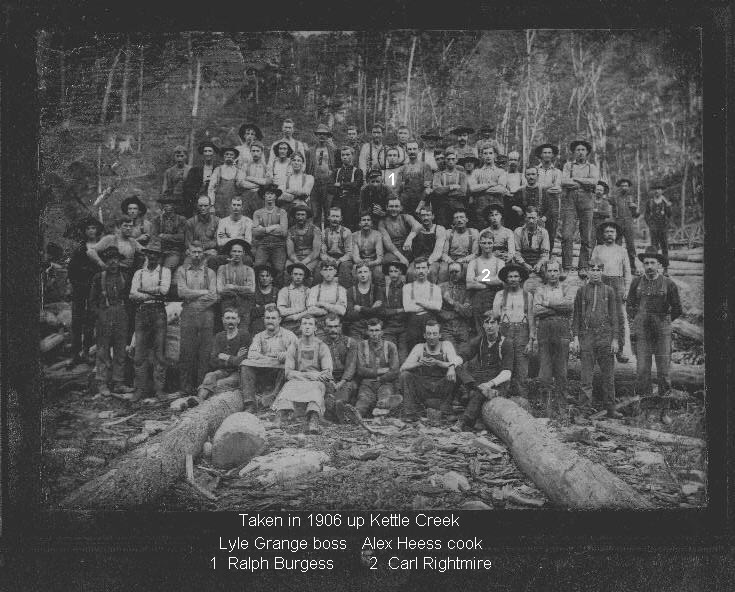
Camp on Kettle Creek
West of Eagles Mere
Sullivan County, PA 1906
Four of the men, including Carl Rightmire, are identified.
Kettle Creek is the site of a "ghost" lumber town that grew up in that area
during the lumber boom, but then was abandoned.
Photo Courtesy of Bettie Burgess Marshinock Daube, Daughter of Ralph Burgess
The preceding picture has a history to go with it. First, as indicated, the
picture is provided courtesy of Bettie Burgess Marshinock Daube,
daughter of Ralph Burgess.Incidentally, Ralph’s son Bruce married Carl’s daughter
Thelma in 1938, some 32 years after this picture was taken.
Ralph Burgess was 22 years old when this picture was taken
in 1906. In 1907 he bought a farm on
Green Mountain (Bear Mountain) about a mile through the woods from his father’s
farm and saw mill, and married Ethel Birdsall.
Ralph then farmed and worked for his father, Bill Burgess, on his mill,
in the woods, or hauling hemlock bark to Hillsgrove or sawn lumber to the rail
siding to get it to market. To my
knowledge, Ralph never again worked in a lumber camp, but he remained a woodsman
throughout his life. In the early 1950’s
he worked as a “straw boss” with his son Bruce and nephew-in-law Johnny Edkins. They
felled timber and cut logs for his son Roscoe Burgess, retiring around
1955 at about age 72. His son Bruce was killed in a logging accident in June 1959. He was cutting
for Roscoe Burgess, working with Johnny Edkin up the East Branch of Mill Creek, off Walkers Road, not too far from Hillsgrove.
It was near the end of the day, the last log truck had left. Johnny was going to fall a large tree, and they had cleared around
it as usual to remove anything that might creat a problem when the tree fell. As the tree was starting to fall, a large limb
that they had not noticed way up the tree, caught the top of a standing dead stub and carried it down a ways; it broke free and
whipped back up, snapped at the bottom and came back over. Johnny looked back just as the dead stub was about 10-feet above Bruce ---
no time for a warning. The stub caught Bruce on the head and shoulder. He died the next morning in the Williamsport Hospital. Logging always was and
is a dangerous line of work.
Carl Rightmire was 16 years old when this picture was taken. This was his first job in the woods. He said he was “pretty small potatoes at
that age”. He remained a woodsman all of his life, and worked in logging
camps extensively up into the 1920’s. He
told me logging and peeling bark was seasonal work In the fall, after the nettles died down so they could see the
ginseng leaves, they would go shanging for about two months. He said they could about double their wages. Shanging was the term used
by these woodsmen for digging up ginseng roots for the Asian market. You can learn more about
this unappreciated resource in the Bradford-Sullivan Forest Landowners Association Newsletter for April/May 2005.
Around 1950 Carl went West to join his son Miles and fell
trees in the “big timber.” He worked in
Idaho and western Montana for a year or two.
He never switched over to power saws, but stayed with the crosscut saw
to the end of his logging days. In the
mid 1950’s, he and Ralph Burgess discussed the merits of the relatively new
power saws --- they maintained that a two-man crew could cut more logs with a
crosscut saw over a power saw. But I
suspect that they were comparing board feet of logs cut in virgin timber versus
board feet of logs cut in second growth.

Lumber Crew at Kettle Creek
July 1904
Source: An old photo reprinted in the Sullivan Review on July 27, 2006
The above picture of a logging crew, also working at Kettle Creek, was taken in 1904. The author of the note
in the caption goes by "Amos", and was likely Amos Wank (1888-1956). Amos appears in other pictures on this page as well.
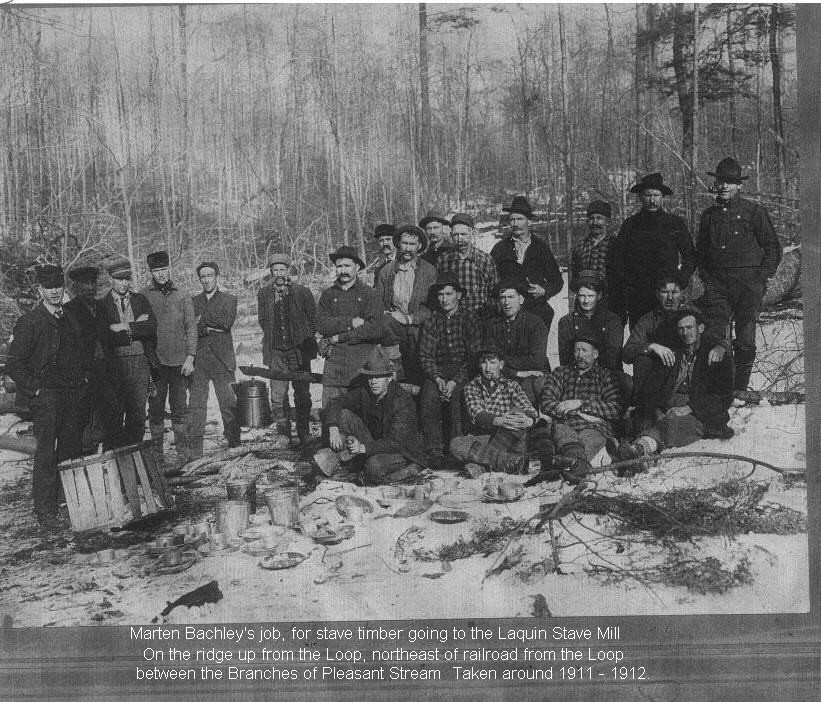
Bachley's Job
1911 or 1912
Source: Photo Collection of George Burgess
Click to see
Identifications by Carl Rightmire

Bachley's Camp on Rock Run
1913
Source: Photo Collection of George Burgess
Click to see
Identifications by Carl Rightmire
Let's digress for a moment to talk about the crew at Bachley's Camp in the years from 1911-1912. One of these individuals was William "Bill" Taylor, indicated by number "39" in the 1913 photo. Bill was the great grandfather of Sharlene Sones, who subsequently sent us two more pictures shown below. Sharlene tells an interesting story:
I was perusing this site and enjoying the photos and background info, when I thought that one of the pictures
looked very familiar to me. In fact, the picture of the men at Marten Bachley's Camp from 1911-12 (sitting around the campfire for a meal)
is hanging here framed in my home!
I believe my great-grandfather, William Taylor, may be standing, front and center (9th man standing from the left, not counting those seated.
He's wearing what appears to be a jacket over a light colored shirt). He is curently identified as Gus Jacoby, and that may be correct, but for now I am not certain. [For sure, he is the man numbered in the 1913 photo.] I have a few other photos that have been passed down to my family
from my late Grandmother Elizabeth Taylor Sones, who was raised around the camps (where her mother did the cooking) and I have lived most of my life nearby in Montgomery, PA.
I'm also interested in learning more about what you may know of the photo and the people in it, as well as Bachley's camp itself. I live not
too far away in the Lehigh Valley and have been having a lot of fun learning about the old logging industry.
Attached are two more pictures. I have others, but they were too large for the scanner and so I'll have to take them out to a Kinko's or something. I'll do that when I'm back on Cape Cod in the next few months.
The first picture is from Bachley's Camp in 1912. I don't know who the folks are, except for the third man standing from the left (wearing a hat, arms crossed) who is my great grandfather William Taylor. He is also the man in the foreground of the second picture, with the bark spud in hand.
This second photo was a postcard. As I mentioned, my grandmother Elizabeth Taylor Sones grew up around these camps and she was the one who identified her father for me. It's a real pleasure to see your website. The whole logging period in the region is such a great slice of history and it's great to see what you've been able to capture and share.
My grandmother's story is so very interesting to me. She lived in dozens of homes (I know of at least 20 or more) growing up in Lycoming and Sullivan Counties, moving around from logging camp to camp. I know she spent quite a bit of time at Highland Lakes, on top of the mountain up there, and attended the school house that still stands. I have such wonderful memories of her stories, although it is so hard to imagine that kind of life! I am so glad to see that you're telling the story of the region. It's so interesting to consider what it must have been like.... Not to mention that I have a keen understanding that the folks from this era had a major hand in shaping and providing me with any advantage I might have in life today. Their lives had a profound effect on mine. I guess that's the beauty of history!
Incidentally, my grandfather and his family lived out at Beaver Lake (they ran the hotel there). I think that is only partially in Sullivan County. Anyway,
I spent many a weekend at family reunions there as a child.
My grandmother, Elizabeth Taylor Sones, told me that moving around (something like 21 homes before she was 20) was challenging and lonely,
with her two older brothers sometimes staying with relatives. She occasionally stayed in the logging camps, as her father Bill Taylor would work there while her
mother, Hattie Barto Taylor, cooked for the entire camp. She made large pots of rivel soup (recipe follows) and other simple dishes. My Grammy was typically
the only child there, so she'd turn to the cats and horses as "friends." She described little tea parties she'd have with her cats, at a small table her mother
set up for her.
I have seen short letters from Bill to his son Mitchell, sent on Christmas Day. The family was living in Muncy Valley, while he worked in Ralston, in the
woods there (I imagine on the Old Logging Path that still remains). I also heard that the camps were quite cold in the winter and the men would often sleep
in their clothes, wet from having hiked back to camp after working in the woods all day, to awake in the morning and find them frozen solid.
My grandmother's parents ended up living just outside of Montgomery (Clinton Township) where she, and her brothers, finished high school. I really don't know
how they did it, with all the moving around, but I know that her parents placed a real emphasis on schooling.
After the Last Raft, Bill & Hattie lived in Montgomery. I know that, late in his years, Bill was challenged with staying in the house -- he much preferred to
be outside and was known to walk for miles.
All in all, it was clearly a tough life, with families struggling to make ends meet and to stay together.
Rivel Soup, recipe of Elizabeth Taylor Sones:
My sister has my grandmother's rivel soup recipe. She used hamburger without milk. Here's her recipe, which you'll see is minimal and without a lot of detail:
Rivels:
- 1 egg beaten
- Add salt
- Add flour until "crumbly"
Boil: hamburg, potato, onion, carrots. When vegetables are cooked, add rivels. Cook about 10 minutes.
Here are the photos from Sharlene:
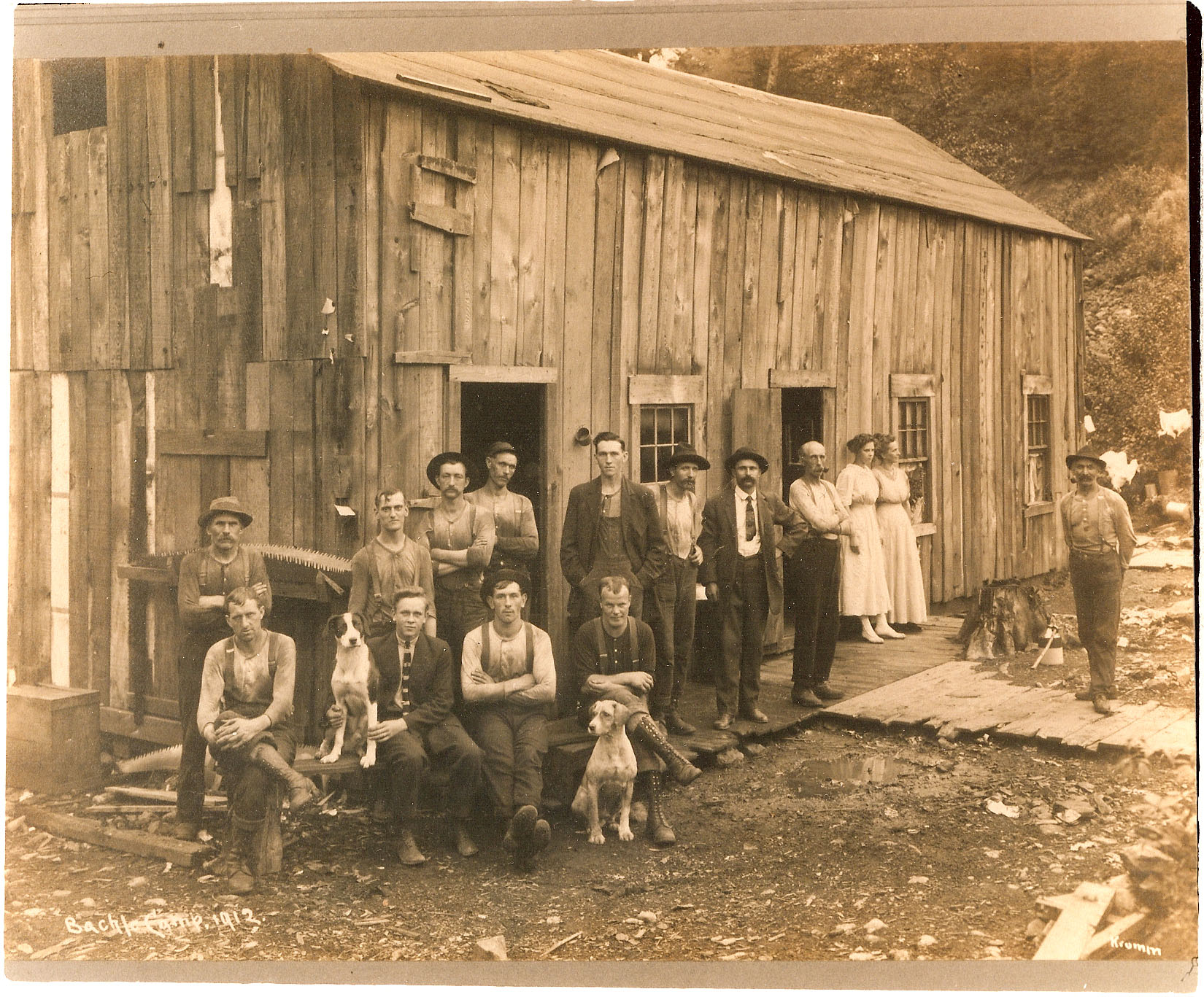
Bachley's Camp
1912
The third man standing from the left, wearing a hat, arms crossed,
is William Taylor.
Source: Photo Collection of Sharlene Sones
Great Granddaughter of William Taylor

Two Loggers
Postcard From Turn of the 20th Century
The man on the left, with the bark spud in hand, is William Taylor.
Source: Photo Collection of Sharlene Sones
Let us know return to the main story with a picture of the Osband Camp:

Osband Camp
Around 1909
Source: Photo Collection of George Burgess
Click to see
Identifications by Carl Rightmire
Here are four pictures of loggers peeling bark, and two other pictures showing hemlock bark being loaded and hauled.


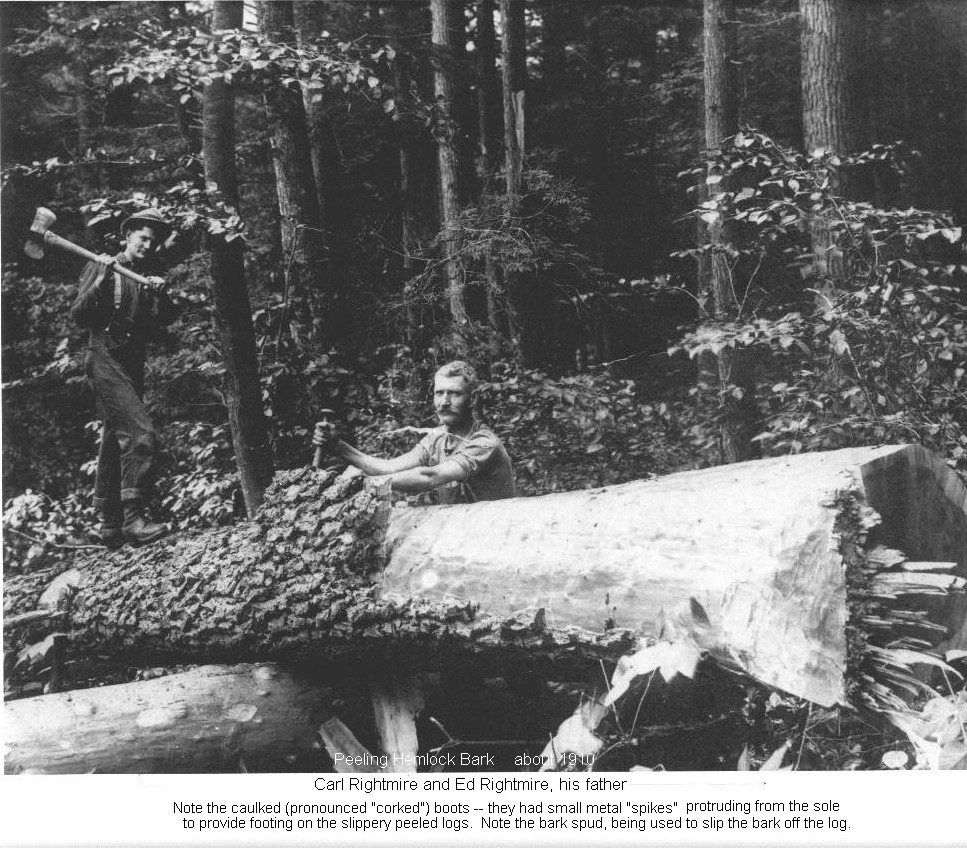
Peeling Bark
Sullivan County, PA
Early Twentieth Century
Source: Photo Collection of George Burgess

Bark Peelers
Unknown
Clyde
Campbell Cameron
Campbell [Clyde’s
brother]
Source: Photo Collection of Bobbie Patterson


Loading and Hauling Hemlock Bark
Sullivan County, PA
Early Twentieth Century
Source: Photo Collection of George Burgess
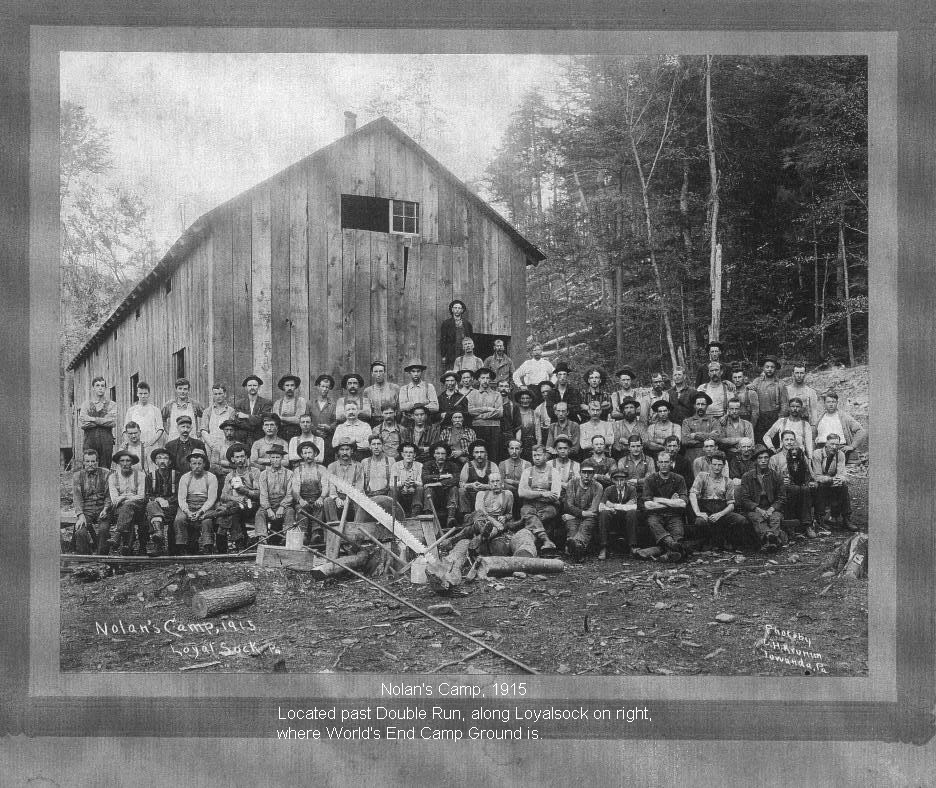
Nolan's Camp
Near the Current
World's End State Park Campground
1915
Source: Photo Collection of George Burgess
Click to see
Identifications by Carl Rightmire
There is an additional story that goes with the preceding picture of Nolan's Camp in 1915. About a month after we posted these pictures of the logging camps, Aaron
Houseknecht wrote in to George Burgess from Seattle, Washington. Here is what Aaron had to say on January 18, 2005:
George
You have no idea how happy I was that you published the photos, or had the photos to be published. I had obtained
several pictures of family members when my grandmother died a few years ago. I put a lot of effort into
finding out who the people were and how they were related to me. I also have a good friend who is a
historian of the Lycoming and Sullivan County areas. He is a great source for the RR and the Civil War
Vets of the area. I grew up in Picture Rocks, PA and I have traced back my family to the 1750s. Many of
my family relative names (not necessarily relatives) are Houseknecht, Stroup, Whitmoyer, Minier, Edkin and
Phillips to name a few. That's a good cross section of the names that are identified in your pictures. I am
even related to "Linc" Edkin, a local mountainman legend. Our family came primarily from Unityville
and Sullivan County. I have greatly enjoyed the Sullivan County website and I am more than glad
(honored really) to contribute to it. Feel free to use the photos but a credit would be nice.
Aaron Monroe Stroup (left unidentified as #62 on the Nolan Camp 1915 photo) is my Great Grandfather. I have never
seen or met the man. Supposedly he died in a railroad accident in Tivoli around 1925. He owned or part owned a
lumber yard there. I know very little info about him really. In the Attached Photo One,
Aaron is on the left and that may be his father, Monroe Stroup, from up Muncy Valley way, on the right. In the Attached Photo Two,
that is Aaron on the left with the double bit axe.
I see that you live in Fairbanks, not too far away from Seattle but probably seems like a real long way from
Sullivan County. I spent a month up in Alaska a few years ago (in the rain surrounded by mosquitos). I graduated
from Hughesville High School in 1974. I have been living in Seattle since 1991. The old logging photos are nice stuff.
Aaron Houseknecht
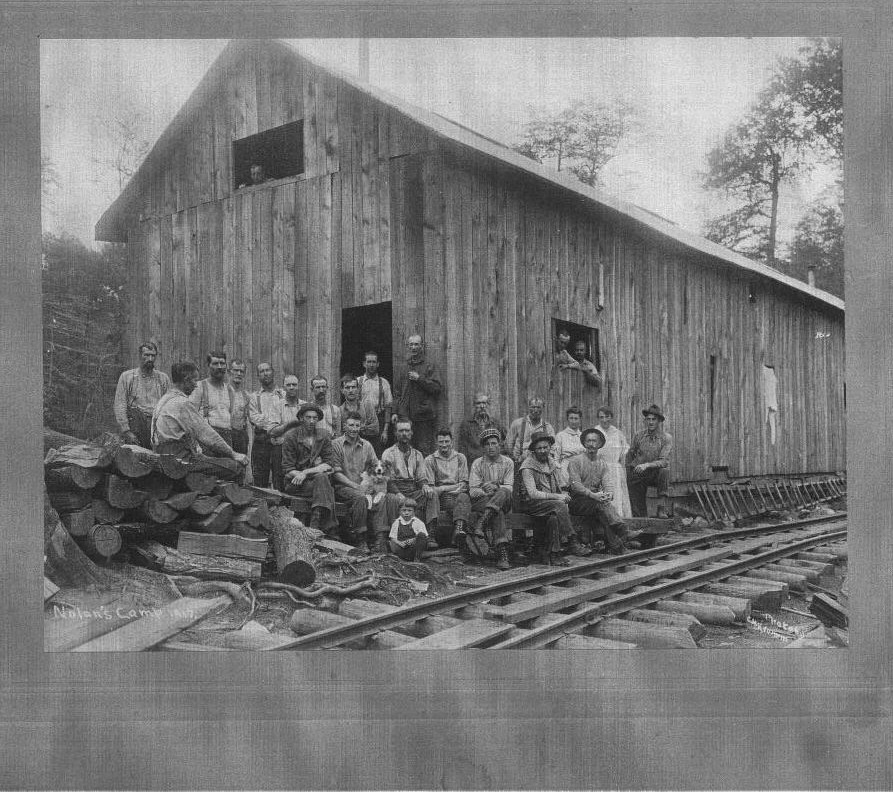
Nolan's Camp
Headwaters of the Middle Branch of Mill Creek
1917
Source: Photo Collection of George Burgess
Click to see
Identifications by Carl Rightmire
Note that in the preceding picture, we are told that the brothers Clyde and Cameron Campbell are on the right side of the photo [see specific identifications]. In 2009, we learned from Bobbie Patterson, great-granddaughter of Clyde Campbell, that their sister Hattie [labeled as Hattie Farrar, wife of Herb Farrar and "cook] is also in the photo as number 20, right behind her brother Cameron ["Camron"].

Osband Brothers Camp
Pleasant Stream
Early Twentieth Century
Source: Photo Collection of George Burgess
Click to see
Identifications by Carl Rightmire
|
